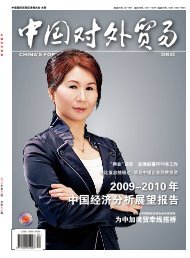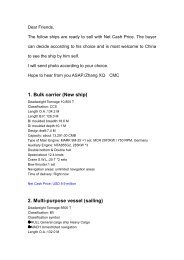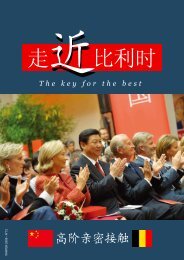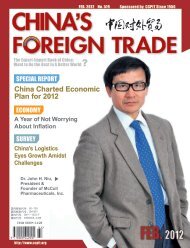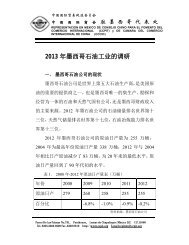F REIGN TRADE - 中国国际贸易促进委员会
F REIGN TRADE - 中国国际贸易促进委员会
F REIGN TRADE - 中国国际贸易促进委员会
You also want an ePaper? Increase the reach of your titles
YUMPU automatically turns print PDFs into web optimized ePapers that Google loves.
governments with limited experiencein health insurance have decided toinvolve insurers in managing and limitingtheir risks. In exchange, insurersare allowed to increase their premiums(or limit their coverage and payouts)whenever the medical claims reacha certain threshold. In the event thatinsurers make a profit, the governmentcan claim a share of the profits. Suchpublic-private partnerships have helpedenhance the management of socialmedical funds. We have already witnessedgood examples of cooperationsuch as the ZhanJiang social medicalsystem, in which a specialized healthinsurer contributed expertise in termsof claims management and risk control,giving the local government a cushionfor its liabilities.Further Understand CustomerInsights and Innovate with Productsand Channels. Shifts in demographicstructure directly change the profiles ofmainstream consumers and their needs.The fast-growing group of relativelyyoung middle-class and affluentconsumers that will become the silversegment in 20 to 30 years time willbecome more and more inf luential,with substantial purchasing power andunique needs. To succeed in the futurewith this segment, insurers should activelyexplore innovations in products,marketing, and distribution.For example, insurers may considerde-averaging customer groupsthrough segmentation, which couldenable them to identify niche segmentswith distinct risk-pricing profiles, allthe while bearing in mind the differencesbetween more-developed andless-developed provinces. For customersin each segment, insurers can also customizevalue propositions to differentiatetheir strategies.Overall, innovative products canbe developed to meet the silver segment’shigher expectation for life qualityand security after retirement.Finally, insurers could try to establishdedicated pension sales andcooperate with HR consulting firmsto address the key needs of the risingsilver segment. Innovative distributionchannels could also be adapted to thissegment’s lifestyle (e.g., distributingthrough hospital networks, or collaboratingwith pharmaceutical companies’distribution networks).Develop Managed Long-TermCare Services. There is a significantgap in long-term care insurance, services,and facilities in China. Investing inlong-term care can offer synergies andadvantages for insurers. The clearest advantageis the ability to offer long-termcare products with services, rather thanfixed payments, as benefits. Also, insurers’investments act as a natural hedgeagainst the risk of increasing costs inlong-term care services.Manage for Profitability andRisks. Economic growth is expected tobe hindered by a shrinking workforceand associated productivity losses.A prolonged climate of low realinterest rates is a likely scenario, whichwould have an adverseimpact on insurers’profitabilitylevels. Looking atJapan’s experience,several insurancecompanieswent bankruptdue to a prolongedlowinterest ratesenvironment,while others managedto adapt andthrive. Chineseinsurers can learnfrom the Japaneseexperience andtake steps to better prepare themselves inasset/liability management and in companyoperations. Several levers are availableto mitigate the impact of prolongedlow rates, including:The other major risk that insurersin China will be facing is longevityrisk. In order to assess this risk, insurersshould consider adopting robust forecastingapproaches and disease-basedactuarial models. A potential solutionto limit longevity exposure on insurers’portfolios is to pass some or all of thisrisk to another insurer or reinsurer withbetter funding and resources to meetthe long-term commitment.The entire insurance industry,including reinsurers, should pushthe public sector to create diversifiedcapital-market solutions, which wouldpotentially allow the transfer of longevityrisk in their annuity/pensionportfolios.Prepare for the Impacts of Agingon Their Own Workforce. Insurers inChina will face challenges in their ownhuman resource management. With astagnant workforce inflow and a muchfaster workforce outflow, insurers willfind it more and more difficult to recruityoung talent and maintain a stableemployee structure.Insurers have a vital role to play inreducing the negative socio-economicthreats from aging in China. Ongoingreforms are encouraging privateparticipation in pension and healthcareprovision, and insurers need to positionthemselves to take advantage of thiswindow of opportunity. Developingprovincial and nationallobbying strategies willbe critical, as will educatingconsumers. Morefocus needs to be put oninnovating product anddistribution channels tobetter serve unmet needs,and better access customers— either as individualsor through employers.And building robust datato support accurate pricingof both medical andlongevity risks will be anessential strategy.In addition, insurerswill be grappling withtheir own challenges. Some of these,like workforce demographic risk, aresimilar to those that other industrieswill face. However, others — such asa prolonged period of low real interestrates — will have direct impact on insurers’profitability.In conclusion, the report proposedthat insurance companies should developa concrete plan for where andhow to participate to take advantageof the challenges and opportunities ofaging. They need to start building thecapabilities and relationships that willbe required to win. And they need toput in place HR strategies to managethe impact on their own workforce.Those that move fast and boldly cancatch the wave — and truly turn silverinto gold.51









